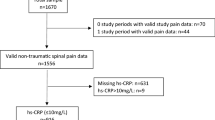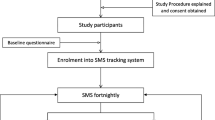Abstract
Purpose
To identify low back pain (LBP) trajectories from early adolescence through to early adulthood and to investigate whether sustained levels of elevated subclinical C-reactive protein (CRP) are linked with these LBP trajectories.
Methods
We analysed longitudinal data from 1513 participants who were enrolled in the Raine Study cohort. Data on LBP with impact on daily living and CRP were collected at the ages of 14, 17, 20, and 22. We constructed group-based trajectory models to identify discrete trajectories of LBP with impact. We then evaluated how the CRP trajectories and the LBP with impact trajectories evolved jointly over time using a multi-trajectory analysis.
Results
The model identified three LBP trajectories. One subgroup included almost half the participants (46.1%) who had a consistently low probability of LBP. Another subgroup comprising 43.5% of participants had an increasing probability of LBP, while one in ten participants (10.4%) had a decreasing probability of LBP. There were no associations between elevated CRP and LBP trajectory subgroup membership.
Conclusion
Although young people follow distinct trajectories of LBP, CRP trajectories do not appear to be a distinguishing factor of the LBP trajectories. Previously reported associations between CRP and LBP may be explained by comorbidity or other factors. Future studies undertaking trajectory analysis should consider comorbidity clusters.
Level of Evidence I
Diagnostic: individual cross-sectional studies with the consistently applied reference standard and blinding



Similar content being viewed by others
Availability of data and materials
The data sets generated during and/or analysed during the current study are available from the corresponding author on reasonable request and with permission of the Raine Study.
References
GBD (2017) Disease and Injury Incidence and Prevalence Collaborators (2018) Global, regional, and national incidence, prevalence, and years lived with disability for 354 diseases and injuries for 195 countries and territories, 1990–2017: a systematic analysis for the Global Burden of Disease Study 2017. The Lancet 392(10159):1789–1858. https://doi.org/10.1016/S0140-6736(18)32279-7
Hartvigsen J, Hancock MJ, Kongsted A, Louw Q, Ferreira ML, Genevay S, Hoy D, Karppinen J, Pransky G, Sieper J (2018) What low back pain is and why we need to pay attention. Lancet 391(10137):2356–2367. https://doi.org/10.1016/S0140-6736(18)30480-X
Hestbaek L, Leboeuf-Yde C, Kyvik KO (2006) Is comorbidity in adolescence a predictor for adult low back pain? A prospective study of a young population. BMC Musculoskele Disord 7(1):29. https://doi.org/10.1186/1471-2474-7-29
Hurwitz EL, Morgenstern H (1999) Cross-sectional associations of asthma, hay fever, and other allergies with major depression and low-back pain among adults aged 20–39 years in the United States. Am J Epidemiol 150(10):1107–1116. https://doi.org/10.1093/oxfordjournals.aje.a009936
Pepys MB, Hirschfield GM (2003) C-reactive protein: a critical update. J Clin Invest 111(12):1805–1812. https://doi.org/10.1172/JCI18921
van den Berg R, Jongbloed EM, de Schepper EIT, Bierma-Zeinstra SMA, Koes BW, Luijsterburg PAJ (2018) The association between pro-inflammatory biomarkers and nonspecific low back pain: a systematic review. Spine J 18(11):2140–2151. https://doi.org/10.1016/j.spinee.2018.06.349
Lim YZ, Wang Y, Cicuttini FM, Hughes HJ, Chou L, Urquhart DM, Ong PX, Hussain SM (2020) Association between inflammatory biomarkers and nonspecific low back pain: a systematic review. Clin J Pain 36(5):379–389
Briggs MS, Givens DL, Schmitt LC, Taylor CA (2013) Relations of C-reactive protein and obesity to the prevalence and the odds of reporting low back pain. Arch Phys Med Rehab 94(4):745–752. https://doi.org/10.1016/j.apmr.2012.11.026
Schistad EI, Stubhaug A, Furberg A-S, Engdahl BL, Nielsen CS (2017) C-reactive protein and cold-pressor tolerance in the general population: the Tromsø Study. Pain 158(7):1280–1288. https://doi.org/10.1097/j.pain.0000000000000912
Afari N, Mostoufi S, Noonan C, Poeschla B, Succop A, Chopko L, Strachan E (2011) C-reactive protein and pain sensitivity: findings from female twins. Ann Behav Med 42(2):277–283. https://doi.org/10.1007/s12160-011-9297-6
Straker L, Mountain J, Jacques A, White S, Smith A, Landau L, Stanley F, Newnham J, Pennell C, Eastwood P (2017) Cohort profile: the Western Australian pregnancy cohort (Raine) study–Generation 2. Int J Epidemiol 46(5):1384–1385j. https://doi.org/10.1093/ije/dyw308
Von Elm E, Altman DG, Egger M, Pocock SJ, Gøtzsche PC, Vandenbroucke JP (2007) The strengthening the reporting of observational studies in epidemiology (STROBE) statement: guidelines for reporting observational studies. Ann Intern Medicine 147(8):573–577
Denham E, Mohn B, Tucker L, Lun A, Cleave P, Boswell DR (2007) Evaluation of immunoturbidimetric specific protein methods using the Architect ci8200: comparison with immunonephelometry. Ann Clin Biochem 44(6):529–536. https://doi.org/10.1258/000456307782268237
Lassale C, Batty GD, Steptoe A, Cadar D, Akbaraly TN, Kivimäki M, Zaninotto P (2018) Association of 10-year C-reactive protein trajectories with markers of healthy aging: findings from the english longitudinal study of ageing. J Gerontol A Biol Sci Med Sci. https://doi.org/10.1093/gerona/gly028
Jones BL, Nagin DS (2012) A stata plugin for estimating group-based trajectory models.
Nagin DS (2005) Group-based modeling of development. Harvard University Press,
Nagin DS, Odgers CL (2010) Group-based trajectory modeling in clinical research. Annu Rev Clin Psychol. https://doi.org/10.1146/annurev.clinpsy.121208.131413
Laursen B, Hoff E (2006) Person-centered and variable-centered approaches to longitudinal data. Merrill-Palmer Q 1982:377–389
Nagin DS, Jones BL, Passos VL, Tremblay RE (2018) Group-based multi-trajectory modeling. Stat Methods Med Res 27(7):2015–2023. https://doi.org/10.1177/0962280216673085
Coenen P, Smith A, Paananen M, O’Sullivan P, Beales D, Straker L (2017) Trajectories of low back pain from adolescence to young adulthood. Arthritis Care Res 69(3):403–412. https://doi.org/10.1002/acr.22949
Junge T, Wedderkopp N, Boyle E, Kjaer P (2019) The natural course of low back pain from childhood to young adulthood – a systematic review. Chiropr Man Ther 27(1):10. https://doi.org/10.1186/s12998-018-0231-x
Linley JE, Rose K, Ooi L, Gamper N (2010) Understanding inflammatory pain: ion channels contributing to acute and chronic nociception. Pflügers Arch Eur J Phy 459(5):657–669. https://doi.org/10.1007/s00424-010-0784-6
O’Sullivan P, Smith A, Beales D, Straker L (2017) Understanding adolescent low back pain from a multidimensional perspective: implications for management. J Orthop Sports Phys Ther 47(10):741–751. https://doi.org/10.2519/jospt.2017.7376
Burton AK, Clarke RD, McClune TD, Tillotson KM (1996) The natural history of low back pain in adolescents. Spine 21(20):2323–2328
Beynon AM, Hebert JJ, Lebouef-Yde C, Walker BF (2019) Potential risk factors and triggers for back pain in children and young adults. A sco** review, part II unclear or mixed types of back pain. Chiropr Man Ther https://doi.org/10.1186/s12998-019-0281-8
Acknowledgements
We would like to acknowledge the Raine Study participants and their families for their ongoing participation in the study and the Raine Study team for study co-ordination and data collection. In relation to the biological essay data used in this study, we acknowledge the in-kind support provided by the following institutions for biosample storage and curation: The University of Western Australia, School of Women’s and Infants’ Health, King Edward Memorial Hospital; The University of Western Australia, Medical School, Royal Perth Hospital; and Telethon Kids Institute. We would like to acknowledge Professor Charlotte Leboeuf-Yde for her assistance in design and supervision. We would also like to acknowledge Professor Anne Smith for her assistance with the revision of the manuscript.
Funding
The core management of the Raine Study is funded by The University of Western Australia, Curtin University, Telethon Kids Institute, Women and Infants Research Foundation, Edith Cowan University, Murdoch University, The University of Notre Dame Australia, and the Raine Medical Research Foundation. The Raine Study Gen2 14-, 17-, 20- and 22-year follow-ups were funded by NHMRC Project Grants (211912, 003209, 403981, 323200, 353514, 1021105, 1027449, 1044840, and 1021858), Safe Work Australia, and the WA Department of Health (G06302). AB is supported by a scholarship from Murdoch University, Western Australia, and a scholarship provided by Chiropractic Australia Research Foundation. JH receives salary support from the Canadian Chiropractic Research Foundation and the New Brunswick Health Research Foundation. The funding sources had no involvement in study design, analysis, interpretation, or manuscript preparation. For the remaining authors, none was declared.
Author information
Authors and Affiliations
Contributions
All authors contributed to the study conception and design. Statistical analysis was performed by AB, JH, and AJ. All authors were involved with the interpretation of the results and drafting the manuscript. All authors reviewed and approved the final manuscript.
Corresponding author
Ethics declarations
Conflict of interest
The authors declare that they have no conflict of interest.
Ethical approval
The Raine Study received ethical approval from the Human Ethics Committees at King Edward Memorial Hospital, Princess Margaret Hospital, University of Western Australia, and/or Curtin University. Ethics approval for the current study was granted by the Murdoch University Human Research Ethics Committee (Approval Number: 2018/226).
Consent to participate
Informed consent to participate in the study was to be obtained from participants (or their parent or legal guardian).
Additional information
Publisher's Note
Springer Nature remains neutral with regard to jurisdictional claims in published maps and institutional affiliations.
Electronic supplementary material
Below is the link to the electronic supplementary material.
Rights and permissions
About this article
Cite this article
Beynon, A.M., Hebert, J.J., Beales, D.J. et al. Multi-trajectory analysis of C-reactive protein and low back pain from adolescence to early adulthood. Eur Spine J 30, 1028–1034 (2021). https://doi.org/10.1007/s00586-020-06677-0
Received:
Revised:
Accepted:
Published:
Issue Date:
DOI: https://doi.org/10.1007/s00586-020-06677-0




